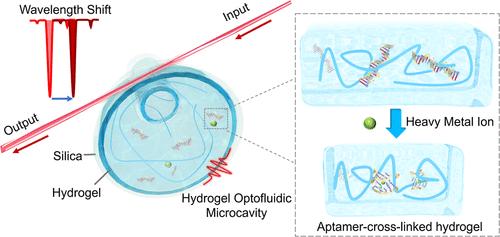用于重金属离子检测的高灵敏度水凝胶光流微腔
IF 9.1
1区 化学
Q1 CHEMISTRY, ANALYTICAL
引用次数: 0
摘要
水凝胶作为检测流体中重金属离子的传感器,已经得到了广泛的发展。然而,由于化学信号的微妙和提取溶液的复杂组成,监测中草药中的多种目标分析物仍然具有挑战性。为了解决这些挑战,我们开发了一种水凝胶光流体传感器,通过水凝胶内强烈的光-物质相互作用来放大分析物信号。该传感平台集成了一层水凝胶膜,封装在一个低语通道模式(WGM)微腔中,用于检测重金属离子,如Pb2+和Hg2+。三维交联的亲水性聚合物网络促进离子从分析物溶液中渗透,诱导明显的WGM共振位移。光谱波长中的红移可以作为量化重金属离子含量的参数。通过对水凝胶进行适配体修饰,实现了光流体传感器的高灵敏度和选择性。最后,使用不同Pb2+浓度的中草药对该平台的性能进行了验证,突出了其在现实场景中的实用性。所提出的水凝胶微腔在开发功能性水凝胶传感器和医疗保健应用方面表现出一种很有前途的方法。本文章由计算机程序翻译,如有差异,请以英文原文为准。

High-Sensitive Hydrogel Optofluidic Microcavities for Heavy Metal Ion Detection
Hydrogels have emerged as promising sensors for detecting heavy metal ions in fluids and have been extensively developed. However, monitoring of multiple target analytes in Chinese herbs remains challenging due to subtle chemical signals and the complex composition of the extracted solutions. To address these challenges, we developed a hydrogel optofluidic sensor to amplify analyte signals through strong light–matter interactions within the hydrogel. This sensing platform integrates a hydrogel film encapsulated in a whispering-gallery-mode (WGM) microcavity for the detection of heavy metal ions, such as Pb2+ and Hg2+. The 3D cross-linked hydrophilic polymer network facilitates ion penetration from analyte solutions, inducing distinct WGM resonance shifts. The red shift in the spectral wavelength serves as a parameter to quantify the content of heavy metal ions. By modification of the hydrogel with aptamers, the optofluidic sensors achieve high sensitivity and selectivity. Finally, the platform’s performance was demonstrated using Chinese herbs with varying Pb2+ concentrations, highlighting its practical applicability in real-world scenarios. The proposed hydrogel microcavity exhibit a promising method for development of functional hydrogel sensors and healthcare applications.
求助全文
通过发布文献求助,成功后即可免费获取论文全文。
去求助
来源期刊

ACS Sensors
Chemical Engineering-Bioengineering
CiteScore
14.50
自引率
3.40%
发文量
372
期刊介绍:
ACS Sensors is a peer-reviewed research journal that focuses on the dissemination of new and original knowledge in the field of sensor science, particularly those that selectively sense chemical or biological species or processes. The journal covers a broad range of topics, including but not limited to biosensors, chemical sensors, gas sensors, intracellular sensors, single molecule sensors, cell chips, and microfluidic devices. It aims to publish articles that address conceptual advances in sensing technology applicable to various types of analytes or application papers that report on the use of existing sensing concepts in new ways or for new analytes.
 求助内容:
求助内容: 应助结果提醒方式:
应助结果提醒方式:


